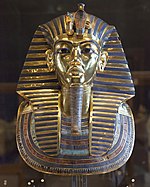Portal maintenance status: (February 2020)
|
|
THE ANCIENT EGYPT PORTAL
Showcased content about Ancient Egypt Ancient Egypt was a civilization of ancient Northeast Africa. It was concentrated along the lower reaches of the Nile River, situated within the contemporary territory of modern-day Egypt. Ancient Egyptian civilization followed prehistoric Egypt and coalesced around 3100 BC (according to conventional Egyptian chronology) with the political unification of Upper and Lower Egypt under pharaoh or king Menes (often identified with Narmer). The history of ancient Egypt unfolded as a series of stable kingdoms interspersed by periods of relative instability known as "Intermediate Periods". The various kingdoms fall into one of three categories: the Old Kingdom of the Early Bronze Age, the Middle Kingdom of the Middle Bronze Age, or the New Kingdom of the Late Bronze Age. Ancient Egypt reached the pinnacle of its power during the New Kingdom, ruling much of Nubia and a sizable portion of the Levant. After this period, it entered an era of slow decline. During the course of its history, ancient Egypt was invaded or conquered by a number of foreign powers, including the Hyksos, the Nubians, the Assyrians, the Achaemenid Persians, and the Macedonians under Alexander the Great. The Greek Ptolemaic Kingdom, formed in the aftermath of Alexander's death, ruled until 30 BC, when, under Cleopatra, it fell to the Roman Empire and became a Roman province. Egypt remained under Roman control until 642 AD, when it was conquered by the Rashidun Caliphate. The success of ancient Egyptian civilization came partly from its ability to adapt to the conditions of the Nile River valley for agriculture. The predictable flooding and controlled irrigation of the fertile valley produced surplus crops, which supported a more dense population, and social development and culture. With resources to spare, the administration sponsored mineral exploitation of the valley and surrounding desert regions, the early development of an independent writing system, the organization of collective construction and agricultural projects, trade with surrounding regions, and a military intended to assert Egyptian dominance. Motivating and organizing these activities was a bureaucracy of elite scribes, religious leaders, and administrators under the control of a pharaoh, who ensured the cooperation and unity of the Egyptian people in the context of an elaborate system of religious beliefs.[1] The many achievements of the ancient Egyptians include the quarrying, surveying, and construction techniques that supported the building of monumental pyramids, temples, and obelisks; a system of mathematics, a practical and effective system of medicine, irrigation systems, and agricultural production techniques, the first known planked boats, Egyptian faience and glass technology, new forms of literature, and the earliest known peace treaty, made with the Hittites. Ancient Egypt has left a lasting legacy. Its art and architecture were widely copied, and its antiquities were carried off to be studied, admired or coveted in the far corners of the world. Its monumental ruins have inspired the imaginations of travelers and writers for millennia. A newfound respect for antiquities and excavations in the early modern period by Europeans and Egyptians has led to the scientific investigation of Egyptian civilization and a greater appreciation of its cultural legacy. (Full article...) Selected article - show another Makuria (Old Nubian: ⲇⲱⲧⲁⲩⲟ, Dotawo; Greek: Μακουρία, romanized: Makouria; Arabic: المقرة, romanized: al-Muqurra) was a medieval Nubian kingdom in what is today northern Sudan and southern Egypt. Its capital was Dongola (Old Nubian: Tungul) in the fertile Dongola Reach, and the kingdom is sometimes known by the name of its capital. Coming into being after the collapse of the Kingdom of Kush in the 4th century, it originally covered the Nile Valley from the 3rd cataract to somewhere south of Abu Hamed at Mograt Island. The capital of Dongola was founded around 500 and soon after, in the mid-6th century, Makuria converted to Christianity. Probably in the early 7th century Makuria annexed its northern neighbour Nobatia, now sharing a border with Byzantine Egypt. (Full article...) Selected picture
Although the camel was known in ancient Egypt from the time of the New Kingdom, it was not used as a beast of burden until the Late Period. Did you know...
News5th September 2018. Rock-cut Tomb discovered in a 4,000-year-old Elite Cemetery August 2018: in the tomb of the mayor of Memphis Ptahmose who dates around 1300 BC was found well preserved cheese, more than 3000 years old. [1] Selected biography - show anotherThe Rock relief of Artaxerxes III in Persepolis Ochus (Ancient Greek: Ὦχος Ochos), known by his dynastic name Artaxerxes III (Old Persian: 𐎠𐎼𐎫𐎧𐏁𐏂𐎠 Artaxšaçāʰ; Ancient Greek: Ἀρταξέρξης), was King of Kings of the Achaemenid Empire from 359/58 to 338 BC. He was the son and successor of Artaxerxes II and his mother was Stateira. Before ascending the throne Artaxerxes was a satrap and commander of his father's army. Artaxerxes came to power after one of his brothers was executed, another committed suicide, the last murdered and his father, Artaxerxes II died. Soon after becoming king, Artaxerxes murdered all of the royal family to secure his place as king. He started two major campaigns against Egypt. The first campaign failed, and was followed up by rebellions throughout the western part of his empire. During the second invasion, Artaxerxes finally defeated Nectanebo II, the Pharaoh of Egypt, bringing the country back into the Persian fold after six decades. (Full article...) General imagesThe following are images from various ancient Egypt-related articles on Wikipedia.
Related portalsWikiProjectsMain topics
Notable Pharaohs
CategoriesRecognized content
Featured articles
Featured listsGood articles
Did you know? articles
Featured pictures
In the News articlesMain page featured articles
Main page featured listsPicture of the day pictures
Things to do
WikimediaThe following Wikimedia Foundation sister projects provide more on this subject:
Sources
Discover Wikipedia using portals |